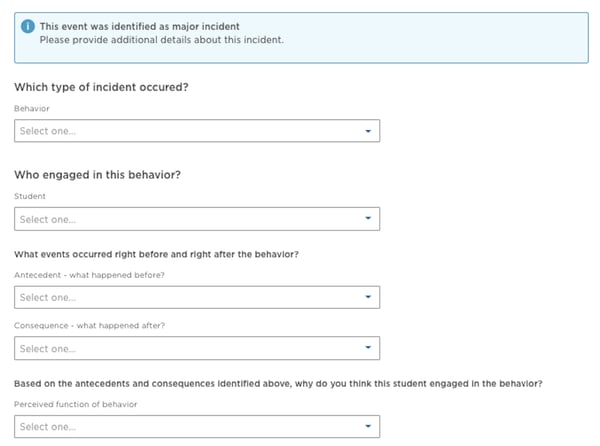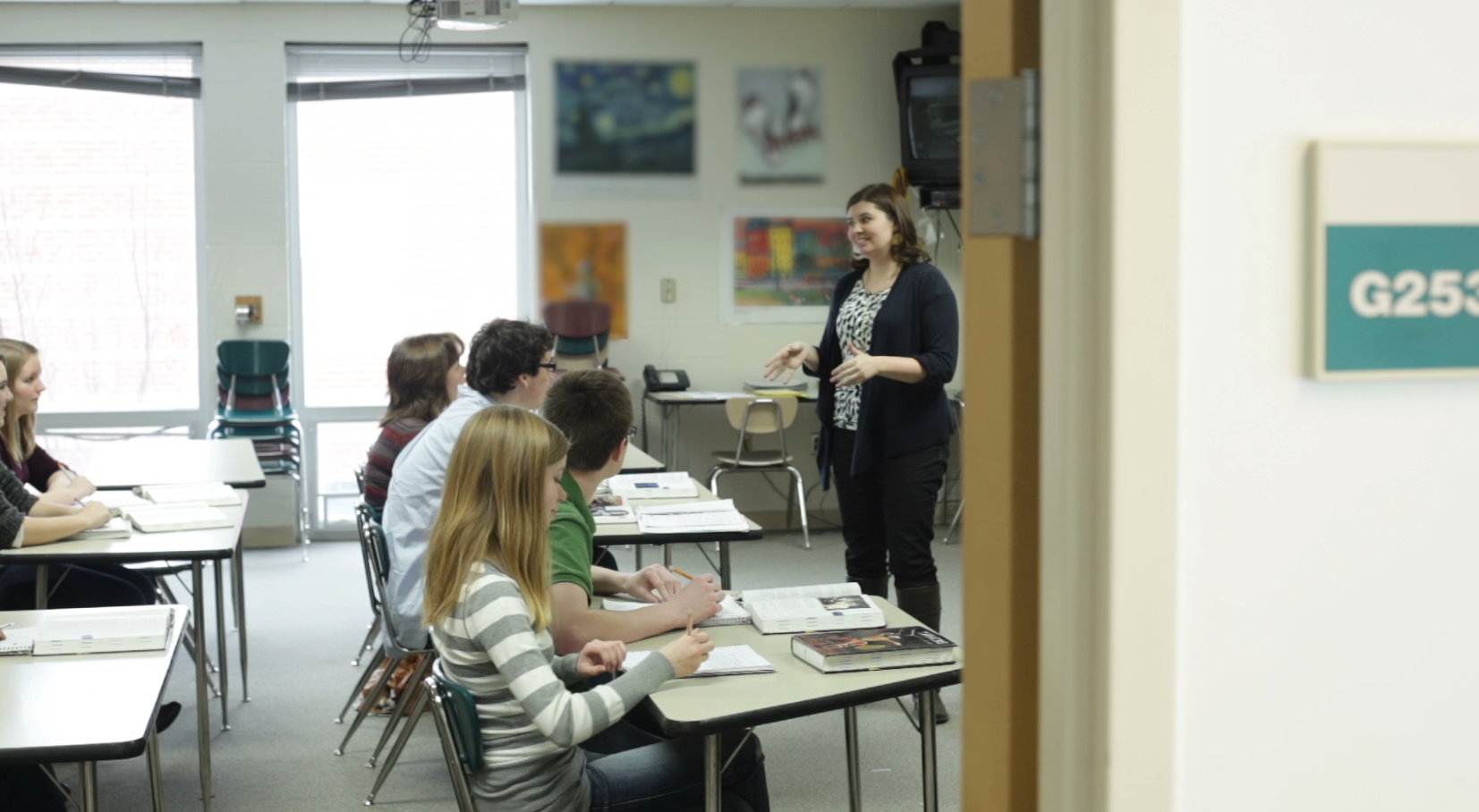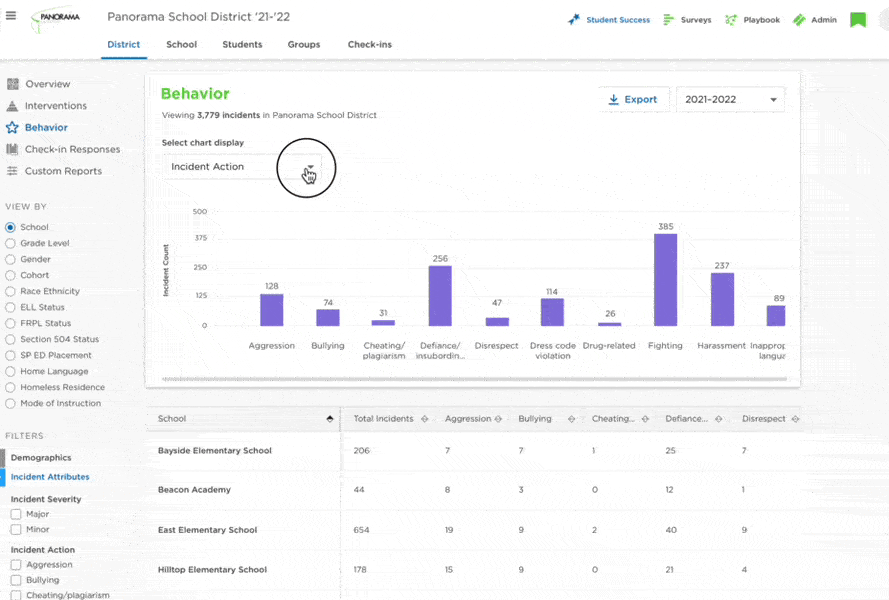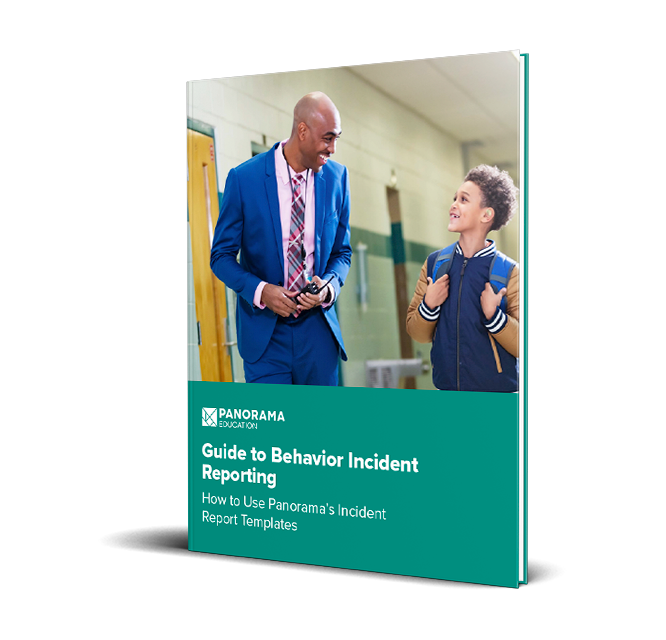These days conversations about student behavior are everywhere, and teachers may be feeling overwhelmed. They’re spending time on behavior incident reports they would rather spend with students, or they’re too overwhelmed to consistently report incidents that occur. They can’t always see how submitting an incident report will benefit their classroom. And they need more support from building leadership on how to prevent and respond to challenging behaviors.
School and district leaders can lighten the load by making behavior reporting practices clear and streamlined. They can also ensure that incident logging is part of a holistic approach that helps educators prevent or address challenging behavior more effectively.
The following best practices for incident logging can create a better experience for teachers and better outcomes for students:
- Build a shared understanding among educators
- Collect the right data for minor and major incidents
- Analyze and act on the data
In this article we unpack each of these best practices, including providing detailed suggestions for exactly what to include in a behavior incident report (BIR) form. And we explore how incident reporting fits into a larger puzzle of building positive behavior supports.
Download Panorama's Behavior Incident Report Templates
Build a Shared Understanding Among Educators
The first step to lightening the student behavior incident reporting load—and making incident logging more effective—is to build shared understanding among educators.
Why build a shared understanding of incident reporting data?
- Ensure reliability. A shared understanding helps make the data consistent and meaningful. If everyone who reports and analyzes data has the same understanding of what constitutes a major incident, then the aggregate data will be more reliable.
- Ease the reporting burden. A shared understanding makes things easier on educators because they don’t spend time questioning the purpose of a field they’re filling out. Educators are also more likely to report incidents with fidelity when they can see how these efforts fit into a systemic approach to behavior. They need access to dashboards for their own classrooms, strategies to address behavior patterns, and support for Tier 1 universal practices that create a culture of more positive behaviors and less need to report on incidents in the first place. Fewer incidents also means less need for administrative follow-up.
- Move toward equity. Alignment on incident reporting across buildings and districts helps to minimize bias in reporting when educators have a clear rubric rather than relying on their gut feelings. Minimizing bias can help to curb discipline disproportionality.
Consider using meetings and professional development time to provide training and ongoing support that develops a shared understanding of the incident report fields and categories on your forms.
|
Did you know? Research shows that disproportionality in exclusionary discipline represents one of the most significant problems in education. In fact, the racial discipline gap has been growing since the 1970s. Source: (Losen, Hodson, Keith, Morrison, & Belway, 2015; U.S. Government Accountability Office, 2013). |
Collect the Right Data for Minor and Major Incidents
Getting clear and consistent on what incident data you’re collecting and why will make for easier reporting and more usable data. Ask yourself: Does your school’s behavior incident report lead to actionable data?
Consider collecting the Big 5 of behavior incident data—what, where, when, who, and how often. The Big 5 can help you see patterns and check hunches like, “It feels like a lot of fights happen in the halls before fifth grade lunch.”
Data collection should be as easy as possible for teachers and other building staff. Make user-friendly forms or use purpose-built software with a friendly user interface, such as Panorama Behavior Logging & Analytics, to underpin your behavior incident report system.
|
Did you know? Incident logging in Panorama Behavior Logging & Analytics makes it easy for teachers and staff to report on behavior events. Log major and minor incidents in Panorama with simple workflows to enter the who, what, where, and when of behavior events. |
Minor Incident Report Form
Minor incidents can typically be handled by a teacher in the classroom without a need for referral. We recommend collecting a few key pieces of data for minor behavior incidents. (These are the same fields included in the Behavior Logging feature of Panorama Behavior Logging & Analytics.)
Consider using or modifying the example template below for your minor incident report forms:
- Date and time: __________
- Behavior Types
- Defiance
- Disruption
- Inappropriate Language
- Physical contact
- Property misuse
- Tardy
- Technology Violation
- Student name(s): __________
- Reported by: __________
- Location: __________
- Notes: __________
Let’s unpack the purpose of each of these report fields:
- The Big 5. The incident report questions collect the Big 5 of behavior data. "Date and time" answers when? "Behavior types" answers what? "Student name(s)" answers who? "Location" answers where? And aggregating the data with Excel or Google Sheets to display the information in a dashboard will answer how often?
- Behavior types. This helps you discover trends in incidents. You may wish to add or subtract a problem behavior from the list to suit your school or district’s needs.
- Reported by. This can support appropriate follow-up. For example, an educator who consistently struggles with certain behavior types may need additional support or professional education.
Example of a minor incident report form in Panorama Behavior Logging & Analytics
Major Incident Report Form
Major incidents typically involve referral to the main office or other resources for follow-up. For major incident reports, the pieces of data you collect may vary based on school, district, or state reporting requirements.
Consider including these fields in your major incident report forms:
- Date and time: __________
- Behavior Types
- Bullying
- Disruption
- Fighting
- Inappropriate language
- Inappropriate location
- Lying/Cheating
- Non-compliance
- Physical contact
- Plagiarism
- Skipping class
- Technology violation
- Theft
- Student name(s): __________
- Reported by: __________
- Location: __________
- Notes: __________
- Antecedent: __________
- Consequence: __________
- Perceived Motivation: __________
- Physical Action: __________
- Outcome: __________
Major incident reports include a few critical fields that aren’t part of minor incident reports: Antecedents, Consequence, and Perceived Motivation. These will help you understand the root causes of the behavior and provide the right supports to address it. You may be familiar with the “ABCs of Behavior”: Antecedents, Behavior, and Consequences. These fields help you to observe behavior via the ABCs.
- Antecedents. This field provides a place to describe what happened directly before the incident occurred, to help you understand the function of the behavior.
- Consequence. This field captures what happened directly after the incident and provides additional information to help determine the function the behavior plays.
- Perceived Motivation. This prompts educators to reflect on what the student might be gaining from the behavior, i.e. the function the behavior serves. For example, a disruptive behavior has an underlying possible motivation to obtain adult attention.
|
Example: A student disrupts class and the incident is reported. In this case, the Antecedent was that the student was given a pop math quiz. The student started tapping their pencil and disrupting others. The Consequence is that the student was removed from class and didn't have to take the quiz. The Perceived Motivation may be to Avoid/Escape Hard Tasks (the pop quiz). |
Major incident report forms also include fields for Physical Action and Outcome to document adult action. Under Physical Action, record whether educators used seclusion and/or restraint such as a physical hold. Under Outcome, record any administrative action taken.

Example of a major incident report form in Panorama Behavior Logging & Analytics (demo data in this form does not reflect real student data)
Analyze and Act on the Data
Collecting data just for the sake of collecting data leaves educators frustrated and, more importantly, misses the opportunity to act on the data to provide supports that students need.
Consider using a data collection system that enables you to share data back to the educators. This can help educators see patterns in their own classroom or in the types of behavior being reported throughout the building.
As a school or district leader, it’s essential to analyze behavior trends at the teacher, school, or district level. Use the information to support your leadership team in making data-based problem-solving decisions that give educators the resources they need to create positive learning environments.
|
Example: Miss Jones is the principal at Lincoln Middle School. She has two hypotheses about behavior at her school. She thinks that most of the incidents leading to out-of-school suspensions are happening in seventh grade, and that the most frequent management challenge that her teachers are having this year with behavior is cell phones in class. Miss Jones uses behavior data to explore and learn more about these hypotheses. Based on what she learns, she and her staff can take action to support all students. |
Strengthen Supports With Proactive Positive Behavior Practices
Incident reporting and data analysis can help you detect, analyze, and respond to problems earlier on—but you can also be proactive with positive behavior practices. You don’t have to wait to collect incident data to begin implementing Tier 1, universal positive behavior practices that support all students.
The best way to minimize behavior incidents and ease the burden on educators? Put Tier 1 supports in place so that all students have the resources and environments they need to meet behavior expectations. Students need to know what expected behavior looks like and may need scaffolding to achieve that behavior, such as through co-creating a Social Contract.
You might also encourage educators to reflect on how their own behaviors create the space for students’ behaviors. Shifting adult mindsets involves empathy and patience, but can be well worth the effort.

Educators can provide proactive positive behavior supports
Get a Full View of Student Behavior In Your Schools
Consider adopting a platform to collect and act on essential student behavior data within your MTSS. With Panorama Behavior Logging & Analytics, educators and administrators can drive whole child supports with streamlined Big 5 behavior data. And that leads to a healthier school culture and more time spent on learning.







